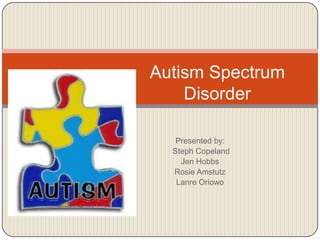
Autism Spectrum Disorder Presentation
- 1. Autism Spectrum Disorder Presented by: Steph Copeland Jen Hobbs Rosie Amstutz Lanre Oriowo
- 2. Definition of Autism The Individuals with Disabilities Education Act [IDEA 300.7 ©(1)(i)] ―A developmental disability significantly affecting verbal and non-verbal communication and social interaction, generally evident before age three that adversely affects a child’s educational performance. Other characteristics often associated with autism are engagement in repetitive activities and stereotyped movements, resistance to environmental change, a change in daily routines and unusual responses to sensory experiences.‖ (i) Autism does not apply if a child's educational performance is adversely affected primarily because the child has an emotional disability. (ii) A child who manifests the characteristics of autism after age 3 could be identified as having autism if the other criteria are satisfied.
- 3. Autism Spectrum Multiple levels of Autism, therefore now considered as a spectrum
- 4. Similarities within the Spectrum
- 5. More similarities within the Spectrum Marked impairments in the use of multiple nonverbal behaviors eye-to- eye gaze, facial expression, body posture, and gestures to regulate social interaction. A lack of spontaneous seeking to share enjoyment, interests, or achievements with other people, e.g., by a lack of showing, bringing, or pointing out objects of interest to other people). A lack of social or emotional reciprocity Delay in or total lack of, the development of spoken language not accompanied by an attempt to compensate through alternative modes of communication such as gesture or mime Encompassing preoccupation with one or more stereotyped and restricted patterns of interest that is abnormal either in intensity or focus. Apparently inflexible adherence to specific, nonfunctional routines or rituals. Repetitive motor mannerisms Hand or finger flapping or twisting, or complex whole-body movements).
- 6. Uniqueness within the spectrum Asperger’s Syndrome Higher IQ Reach milestones at the right time Do not have communicative impairments Rett Syndrome Usually only found in girls Normal development until 6 – 18 months Hypotonia - loss of muscle tone, no eye contact, decelerated head growth Rapid developmental regression – hand wringing, unsteady walking, breathing irregularities, seizures. PDD – NOS Diagnosed when child displays some autistic behaviors and meets some but not all criteria for PDDs. Example from the book(pg 363) – an individual with severe impairments in social interactions and communication but no repetitive behavior CDD Normal development until a certain age (between 2 and 10) and then regress
- 7. Prevalence ASD Prevalence – 1 in 91 children is diagnosed 1 in 58 boys is diagnosed with autism Boys 4 times more likely to have ASD In order of most to least PDD – NOS and Autism About 10 in 10000 Asperger’s Syndrome About 2.5 in 10000 Rett’s Syndrome & CDD Less than 1 in 10000
- 8. Autism on the RISE! • Autism prevalence figures are growing • More children will be diagnosed with autism this year than with AIDS, diabetes & cancer combined. • Autism costs the nation over $35 billion per year, a figure expected to significantly increase in the next decade. • Autism receives less than 5% of the research funding of many less prevalent childhood diseases. ASD - fastest growing disability category in the IDEA Greater awareness of Autism Improved methods of identification Increased awareness that autism can exist at different IQ levels
- 9. Theoretical Causes Genetic Disorders Vaccines Exposure to Food Sensitivities Environmental factors: o Yeast o Toxic Chemicals o Gluten o Heavy Metals o Casein
- 10. Is there a cure? Controversy with Jenny McCarthy Jenny McCarthy Story
- 11. Living with ASD
- 12. Teaching Strategies ENVIRONMENTAL ADAPTATIONS Visual cues & Picture Schedule To modify behavior Aide with transitions Assist with learning strategies Teacher Aide To support desired behavior DIFFERENTIATED INSTRUCTIONS Assignments broken down into smaller tasks ASSISTIVE TECHNOLOGY/ADAPTATIONS Communication Pictures Electronic devices Shortened writing utensils, weighted pens, grips Highlighters Sensory Input: core disk, weighted vest, fidgets, oral devices STRATEGIES Prompts for transitions: verbal & visual cues, establish a social story Repetitive instruction, rephrasing questions, redirection to activities, modeling of task, reinforcement Look at antecedent behaviors to address behavior before it escalated to an undesirable behavior. Movement prior to tasks—helps attending Students need to know what is expected of him (beginning, middle, & end) and attach meaning to it
- 13. History of Social Stories Developed by Carol Gray for persons with autism in early 1991 Written for children and adults with autism spectrum disorders by students at Jenison High School in Jenison, MI. Autism Social Story Guidelines Write a social story from the perspective of the person with autism. Create a word picture – what they would see and experience Use a combination of different types of sentences, following the recommended ratio: Descriptive, Perspective, Directive May be supplemented with additional, optional types of sentences: Affirmative, Control, Cooperative
- 14. Social Story
- 15. The Sky is the Limit!
- 16. Questions?
- 17. Resources http://www.aspergers.com/ www.Autismspeaks.org http://www.cde.state.co.us/cdesped/SD-Autism.asp http://www.specialed.us/autism/asper/asper11.html http://www.rettsyndrome.org http://www.barberinstitute.org/autismINsight/disorder_pe rvasive.php http://www.barberinstitute.org/autismINsight/disorder_pe rvasive.php www.child-autism-parent-cafe.com/how-to-write-a- social-story.html
